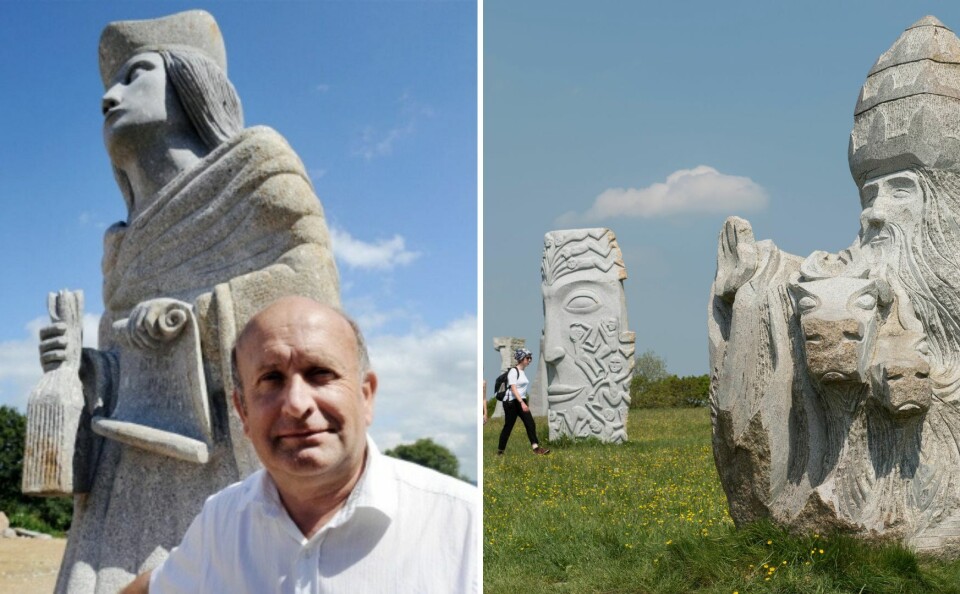-
Visitors to Normandy American Cemetery must soon book in advance
With more than one million visitors last year, the cemetery is one of the region’s most-visited D-Day sites
-
Easter traditions across France: From rattles and hooded processions to giant omelettes
Regional Pâques celebrations highlight France’s cultural diversity
-
Photos: 94 chateaux open their doors to visitors in Dordogne
The fifth Chateaux en Fête festival offers a chance to look around many impressive properties that are usually private
Brittany's new 'Stonehenge' site will reconnect us to roots
Philippe Abjean’s latest project in Brittany, StoneBreizh, will highlight the region’s cultural history since the Neolithic period

Breton Philippe Abjean is co-founder of StoneBreizh, a new Stonehenge-inspired monumental 36-stone site in Brittany due to open this summer.
The project’s aim is to promote the region’s history since the Neolithic period.
Read more: A new Stonehenge-like site set to be built in central Brittany
Read more: Brittany’s historic stones vying for World Heritage status
Mr Abjean has a passion for transmitting knowledge, having founded other monumental sites such as the Vallée des Saints or the Tro Breizh trail.
He is also a Christian dedicated to reinventing spirituality in an increasingly connected world.
What are your ambitions for StoneBreizh?
StoneBreizh aims to tell the history of Brittany from the Neolithic period.
The name is a reference to Stonehenge, of course.
The idea is to create something monumental and emblematic of Brittany, since the land is home to menhirs, dolmens and stone circles.
It will add one more stone monument to the existing collection of more than 40 within Brittany.
I want it to be a place of festivities, a place of life.
I want to reconnect people with the cultural history of Brittany in an increasingly digital, virtual world.
Choosing these granite stones to do so is provocative considering the world we live in, in which everything needs to be done faster and faster.
Brittany must set the tone for other regions or countries that want to show pride in their history.
It does not mean a return to the past or retreating into its image of itself, however. This is not part of the Breton identity.
The first stone will be laid on June 21. What is the symbolism behind the date?
Well, it’s mostly to reignite the tradition of the Saint-Jean celebration that takes place on June 23.
It was celebrated everywhere in Brittany when I was a child, with people lighting bonfires all around the region.
It was slowly replaced by the Fête de la Musique.
The fire will be surrounded by 36 menhirs measuring between six and seven metres tall, topped by lintels.
The idea is to carve symbolic elements of both Druidism and Christianity to highlight the sacredness of the place.
Druidism had not entirely disappeared from Brittany but Christianity overlapped with it.
The Toussaint celebration is crucial in the region because its roots lie in Samain, an ancient Druid and Celtic celebration where everybody could speak with the dead for three full days.
Legends in Brittany often refer to the “other world”, a notion essential for understanding them.
Behind the Christian veneer, we have not forgotten this other world.
From the ashes of a disappearing Christian culture resurges an old Celtic tradition.
Why did you choose to locate StoneBreizh in Carhaix?
Firstly, because Carhaix is 15 kilometres away from the Vallée des Saints. This helps to create a package for visitors to visit two historic sites in one day.
Secondly, because Carhaix is home to some of the most monumental Neolithic works.
Archaeologists are excavating a cairn more than 5,000 years old that could very well be the largest in Brittany, just 800 metres away from the StoneBreizh site.
Carhaix was also the central town from which every road departed during the time of the Roman Empire.
It seemed logical to place StoneBreizh there.
You were born in the Champagne region but you are from Brittany
Of course. I would like to say you can be from Brittany by birth or by will.
My mother was born in Champagne and my father in Saint-Pol-de-Léon, a town in Brittany.
When he was captured by the Nazis, the troops stopped in Champagne where he met my mum, who jotted her address on a note.
My father was kept prisoner for five years.
After his release, hers was the only address he knew.
I was born in Champagne but moved back to Brittany after my parents married.
You have studied and taught philosophy. Has this influenced all your projects?
Undeniably. I would choose the same subject if I had to do it again.
Philosophy gives you insight.
Philosophy is a school of wisdom that provides relativity.
Teaching in Cameroon also influenced me greatly.
When I was there, I witnessed a certain black Africa preserved from the modern world, with different ethnicities and languages.
People were wise and happy despite poverty. They became less happy the richer they got.
Unfortunately this has since disappeared completely.
Have your projects been part of a desire to not be forgotten? Both the Brittany you grew up in, and your childhood?
My personal ethic is to refuse fatalism, even when most people accept every form of decline and disappearance, taking refuge behind the secularisation movement.
I think it’s part of the people of Brittany to persevere. Even if religious faith is gone, fidelity remains.
I am convinced nothing is lost forever.
I think firestorms can be created by lighting small flames.
One of our other upcoming ambitious projects will see a 15-metre tall statue erected to celebrate the 400th anniversary of Saint Anne.
Is this an ambition that goes hand in hand with the Ouvrier du Bon Dieu, an association you created to save churches from abandonment?
Forty-five thousand churches are sold or shut down each year. The idea is to buy them back to save the town.
When a church closes, part of the town’s identity disappears. I want them to become places where silence will reign.
I want churches to become a place where people can find themselves.
I hope co-ownership solutions can be found, although I have stagnated a bit on this project.
British people are smarter about this. Look at the National Trust for example. They take iconic sites and turn them into profitable businesses with paying tickets.
It is interesting that you mention the National Trust. Is this what happened with the Vallée des Saints?
My project was meant to be for spiritual and cultural purposes, while others had more economic goals, based on the fact that 400,000 people come every year to the Vallée des Saints.
I think the spiritual element has gone from there now. A part of the valley’s soul left when they started selling parking tickets.
StoneBreizh will not charge customers.
Are these projects meant as a path to rediscover spirituality? Is it your contribution to the Church?
Absolutely. I am disheartened by global resignation that everything is bound to fail. The only thing I am certain about is that the Church should be reinvented.
The Church’s decline is, in my opinion, created by the loss of spirituality.
The first Christians thought that Man was composed of a trinity of body, soul and spirit.
The spirit, which used to connect them to transcendence, then disappeared.
This primitive message is reduced to mere moral considerations nowadays. This attitude is unadapted to modern society.
We need to go back to our origins.
This is part of a colossal project, I agree. StoneBreizh is part of a tiny effort attached to a much larger movement, like the hummingbird offering grain after grain to the mill.
This is not much, but it has to be done anyway.
Related articles
Do you have Breton 'name bowls'? Here is how they are made
Brittany votes to ask for autonomy from France after Corsica statement
From France’s Eurovision entry to Harvard: Five Breton language facts
























